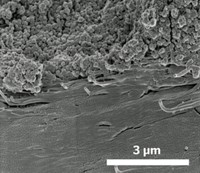Advertisement
Grab your lab coat. Let's get started
Welcome!
Welcome!
Create an account below to get 6 C&EN articles per month, receive newsletters and more - all free.
It seems this is your first time logging in online. Please enter the following information to continue.
As an ACS member you automatically get access to this site. All we need is few more details to create your reading experience.
Not you? Sign in with a different account.
Not you? Sign in with a different account.
ERROR 1
ERROR 1
ERROR 2
ERROR 2
ERROR 2
ERROR 2
ERROR 2
Password and Confirm password must match.
If you have an ACS member number, please enter it here so we can link this account to your membership. (optional)
ERROR 2
ACS values your privacy. By submitting your information, you are gaining access to C&EN and subscribing to our weekly newsletter. We use the information you provide to make your reading experience better, and we will never sell your data to third party members.
Materials
Study shows thicker hair isn’t necessarily stronger
Study finds counterintuitive breaking patterns in various mammal hairs
by Kerri Jansen
December 13, 2019
| A version of this story appeared in
Volume 97, Issue 48

Keratin-based biomaterials that mimic the properties of hair, which is tough and strong for its weight, could one day be used in medical devices or cosmetics. But to accomplish that, scientists will need to replicate the internal structure of hair and the way individual structural elements bond to one another. A hair consists of bundles of keratin fibers connected by chemical bonds and surrounded by layers of scales called cuticles. A team led by Robert O. Ritchie at the University of California, Berkeley, and Marc A. Meyers at the University of California San Diego found that these elements interact differently in various types of hair (Matter 2019, DOI: 10.1016/j.matt.2019.09.019). The team collected hair from several mammal species, including humans, and pulled strands until they broke. The researchers examined the broken ends with scanning electron microscopy. They found that thin hair, such as human hair, tends to break in long cracks, with individual keratin fibers coming unstuck. Thicker hair, such as elephant hair, tends to break cleanly straight across. Counterintuitively, the researchers found that thin hair tends to be stronger than thick—a phenomenon they suggest is related to the size and quantity of flaws in the hair strand. One exception was capybara hair, the strands of which have an indent down the middle believed to help shed water. That hair tended to fail along that center line, giving it a lower tensile strength than expected.





Join the conversation
Contact the reporter
Submit a Letter to the Editor for publication
Engage with us on Twitter